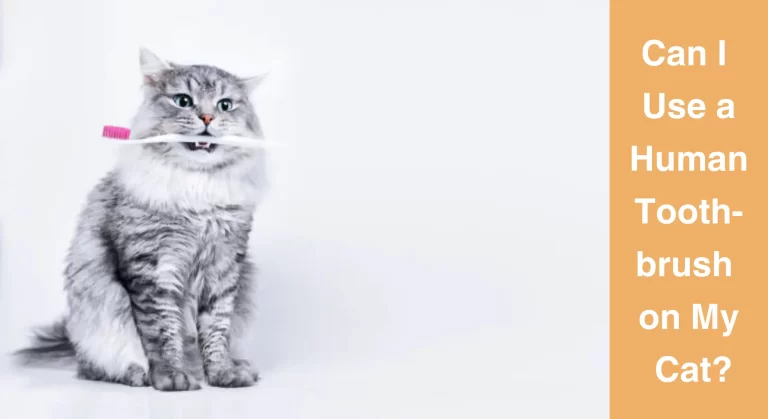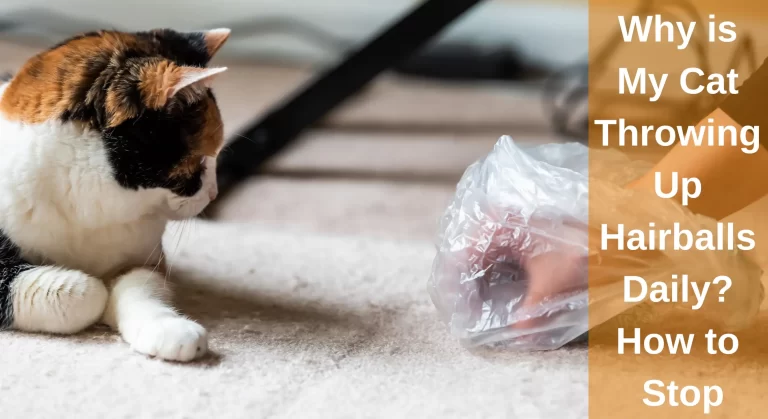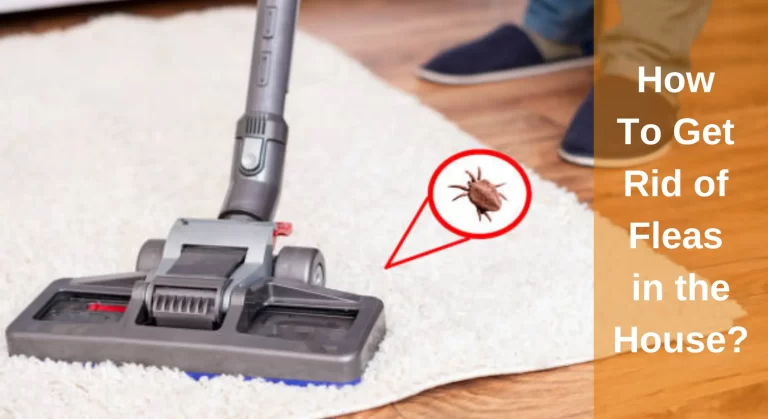My Cat Has Worms How Do I Clean My House? [A Complete Guide]
Worm infestations in our beloved pets are a challenge in itself, but cleaning up after the infection is a long and daunting task. Pets are particularly vulnerable to parasitic worms if they live in an unclean environment or have parasitic worms in their environment. The effects of worms on cats are uncommon, but they can be harmful to your pet and your family.
If you have multiple pets, this nuisance can be easily transmitted to them all. It can even be transmitted to you, which is the last thing you’d want. The recommended method for preventing and overcoming parasitic worm infestation is avoiding and eliminating them.
“My cat has worms how do I clean my house”: To clean your house when your cat has worms, start by thoroughly vacuuming all surfaces, including carpets and furniture. Wash your cat’s bedding and linens in hot water, and disinfect their furniture and accessories. Clean and disinfect the litter box, and maintain proper hygiene in food and water areas. Taking these steps will help eliminate worm eggs and create a clean, safe environment for your cat and family.
In this article, we will explore the significance of a clean house for your cat, identify signs of worm infestation, discuss cleaning strategies, preventive measures, and safe cleaning products, and provide additional tips to ensure a worm-free home.
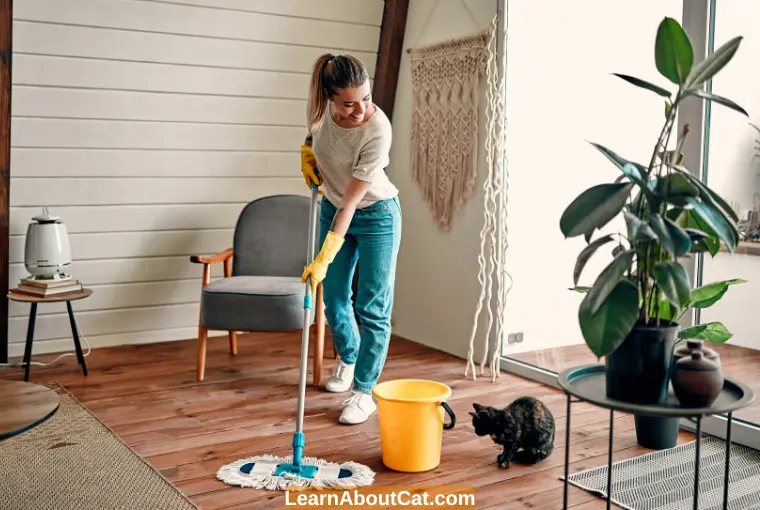
How Do Cats Get Worms?
Cats can get worms through various sources and modes of transmission. Here are the ways different types of worms can infect cats:
- Roundworms: Kittens can acquire roundworms from their infected mother through the placenta or while nursing. Cats can also get roundworms by ingesting contaminated soil, water, or prey.
- Tapeworms: Cats usually get tapeworms by ingesting fleas during grooming or hunting activities. Fleas act as intermediate hosts, carrying tapeworm larvae that develop into adult worms in the cat’s intestines.
- Hookworms: Cats can contract hookworms by ingesting the larvae present in contaminated soil, feces, or through direct skin penetration. Kittens can also acquire hookworms from an infected mother’s milk.
- Whipworms: Whipworm infection in cats occurs when they ingest whipworm eggs present in soil, water, or contaminated food.
- Heartworms: Cats can become infected with heartworms through mosquito bites. When an infected mosquito bites a cat, it transfers heartworm larvae into the bloodstream, which eventually mature into adult worms in the heart and lungs.
My Cat Has Worms How Do I Clean My House
For a thorough house cleaning, you need the following things:
- Hand washing liquid
- Hot water
- Soapy water
- Carpet Shampoo
- Bleach
- Vinegar
- Vacuum cleaner
- Steam cleaner
- Accelerated hydrogen peroxide
Steps to Clean Your House After a Tapeworm or Roundworm Infestation are as follows:

1. A Visit to the Vet / Deworm Your Cat
The first thing to do is to cure your cat. Worms need a host to survive; your cat may have gotten them while exploring the outside world or accidentally swallowing fleas while cleaning itself. Cats with fleas are more prone to worm infestations as fleas carry the worm eggs inside them.
If tapeworms infect your pet, you will find rice-grain-like eggs in the fur of your cat’s anus or in its litter box. Roundworms are more common in kittens. Hookworms (Ancylostoma) can make your cat very sick, and Heartworms (Dirofilaria immitis) can be very dangerous for your pet. You must take your cat to the vet for a definitive diagnosis.
Your veterinarian will prescribe deworming medication specific to the worm that has infected your pet. If your pet has fleas, your vet will make sure to address that, too, as fleas are a carrier for worm eggs.
Once you have actively gotten rid of the site where worms were reproducing and thriving, it’s time to thoroughly disinfect your house.
2. Protect Yourself – Wear Gloves
As long as you do not want to get infected while cleaning your house, protective gear is vital. You don’t want to accidentally ingest or inhale one of these eggs (roundworm eggs are airborne).
Make sure to wear disposable items. Gloves and boots are a must, as well as an N95 mask, especially when handling the litter tray. Wear an apron to protect your clothes. Arrange some old newspapers, plastic bags, and paper towels as well.
3. Clean the Litter box
This is the most necessary part of the process, as worm eggs can be passed through feces. You must clean out the litter box daily while your pet is still infected. Scrape off any wet litter that may be sticking to the pan, then spray a mixture of boiling water and bleach on the base and sides of the pan. Wipe it clean with paper towels and dispose before adding fresh litter.
4. Clean up Vomit and Feces
Hard surfaces
Of course, a sick cat will leave its mark everywhere. It is important to clean these spots vigorously, not only to get rid of the awful smell but to kill worms and eggs too. If the throw-up or excrement is on a hard surface, Make sure to use paper towels to soak up as much of the mess as you can if the vomit or other waste is on a hard surface. Follow up with a disinfectant spray to eradicate any traces of worms or their eggs.
- If the vomit or feces has dried, apply a detergent spray to soften the stain.
- Allow the detergent to sit on the area for five to ten minutes.
- Prepare a bucket of hot, soapy water and use a damp sponge to scrub the affected area.
- Rinse the area thoroughly and repeat the process if necessary.
- Blot the surface dry with paper towels.
- Proper disposal of the sponge and paper towels is essential to prevent the spread of any potential contaminants.
Soft surfaces
The situation is a bit more challenging to handle when it comes to carpet messes. First, wipe as much as possible, then use a good carpet cleaner on the stain. It is recommended to use an enzymatic cleaner as enzymatic cleaners break down unwanted substances rather than just mask the smell. Use it several times instead of going in once with a concentrated cleaner to prevent damage to your carpet and floor.
- After the area has been cleaned, employ steam cleaning to eradicate any potentially lingering eggs that may have contaminated the surface.
- Steam cleaning provides a high-temperature treatment that effectively kills remaining parasites or eggs.
- This step is vital to prevent reinfestation and ensure a hygienic living environment.
5. Clean All Surfaces in the House
Because cat hair flies everywhere, eggs can be on any surface of your house. So it’s important to polish every surface. Bleach and boiling water can do the trick, however, keep the concentration of bleach to a moderate amount, or you may damage your furniture.
Disinfectant sprays or enzymatic cleaners are suitable too. Make sure to wipe down every nook and cranny; you never know where eggs are residing.
6. Sterilize Your Carpets
Eggs can last a long time in the crevices of carpets, so it’s essential to clean them out properly. You want to thoroughly vacuum your carpet, and then steam clean it, as heat is the best way to get rid of them. Then, sprinkle salt over your carpet and let it rest for a few days. Finally, vacuum up the salt, dead worms, and eggs.
Make sure to regularly steam vacuum your carpet to remove any worms or eggs that may be there.
7. Clean Your Furniture
Worms and eggs can easily be transferred from your cat’s fur, so you will need to clean out every surface your pet has been on, even the soft surfaces. Like carpets, eggs can get into crevices and survive for weeks, so you must do a thorough cleaning job.
Smaller items like blankets, plushies, bed sheets, and cat toys can easily be thrown into the washing machine. Make sure to set it on the hot cycle, as heat is the enemy of worms and eggs.
For larger surfaces like sofas and chairs, you will want to steam clean them. Hot water and detergent can be used to clean leather furniture. You need to get deep into the sofa as eggs can reside anywhere, and the last thing you want is another worm infestation.
8. Clean your Patio
If you have an outdoorsy cat, you will need to do this. Worms and eggs can easily be residing on your patio, rendering deep cleaning your house pointless. Boiling water and bleach works best here. Simply pour it all over the concrete.
If you have a small garden in front of your house, you can cover it with plastic. The plastic sheet will allow UV rays to pass, killing the eggs and worms. Alternatively, you can remove the top part of the soil. Stray cats may use your garden as a litter box, so you will need to either scare them away or scoop after them, as they may be carrying worms.
9. Dispose of or Disinfect Cleaning Tools
Once you are done deep cleaning your entire place, it is time to dispose of or disinfect the tools you use. You can dispose of gloves, aprons, litter, cleaning rags, and your N95 mask in a garbage bag, then put it in another garbage bag to seal it off completely.
Throw it out in a landfill, away from your home. Wipe down your vacuum cleaner and steam cleaner with hot water, then spray some disinfectant spray.
You Might Also Like to Read: Why My Cat Has Scabs on Its Neck But No Fleas?
How Do Cats Get Worms?
Cats that spend most of their time outside are more likely to get worms than those who spend most of their time indoors, but cats that don’t go outside can also become infected. Cats will probably become infected if they come into contact with infected eggs or feces.
It is likely that the cat will eat any eggs that become attached to its coat or paws as it grooms itself, leading to it becoming infested.
If cats live in a household with multiple cats, they are more likely to become infected, especially if they share a litter box. The risk of infection is higher for outdoor cats hunting small rodents with worms. Additionally, hookworms and roundworms can infect cats via dog poop containing their eggs.
There is also a possibility that tapeworms can develop through fleas. Cats can get tapeworms from fleas ingested while grooming, even if they are kept indoors. Fleas can jump from dogs to cats and ingesting fleas can cause tapeworms.

What are the Symptoms of Worms?
It depends on the level of infestation. Some cats may be asymptomatic. However, many presents with:
Changes in Coat Condition – Dull Coat
- Normally, a cat’s fur appears glossy. However, if the cat has a worm infection, its coat may appear flat or dull.
- The loss of luster can indicate poor nutrient absorption and dehydration due to the illness.
Gum Color
- A healthy cat’s gums should have a pink color, similar to ours. Pale or white gums suggest anemia, which is commonly caused by parasite infections.
- To examine the cat’s gums, gently hold its head behind the ears and under the jaw. Lift the flap of the upper lip to reveal the teeth.
- If you notice pale gums, it’s important to schedule a veterinary appointment promptly.
Observing Feces – Tarry stools
- If your cat uses a litter box, it becomes easier to assess its feces. When observing the samples, watch out for the following signs:
- Sticky and black stools may indicate blood loss, potentially caused by hookworms attaching to the intestinal walls.
- Diarrheal stool pieces can suggest the presence of worms in the gut, leading to improper digestion of food.
- If your cat experiences severe diarrhea persisting for more than 24 hours, immediate veterinary attention is necessary.
Changes in Eating Habits – Loss of Appetite
- Cats with a heavy worm burden may experience a loss of appetite. The worms take up space in the stomach, distended abdomen, inflame the gut lining, and cause stomach discomfort.
Fatigue and Lethargy
- If worms are sapping the cat’s nutrients, it may exhibit signs of fatigue, lack of energy, weight loss, and overall sluggishness.
- Keep a close eye on your cat’s behavior and note any significant changes.
You may find worms in the vomit or feces if the infection is severe. Severe symptoms are dehydration, pale gums, lethargy, seizures, and, if untreated, can lead to death.
It’s best to take your cat to your veterinarian right away if you suspect your cat might have worms. The absence of worms in your cat’s feces doesn’t necessarily mean that your cat doesn’t have them. It is necessary for veterinarians to examine cat poop under the microscope in order to find worm eggs.
How Do I Deal With Worms?
Once your pet is diagnosed with worms, your vet will prescribe an effective dewormer in the form of a pill, injection, or liquid. You need to give the medicine regularly as prescribed. Your vet will recommend an effective flea medication if your cat has fleas.
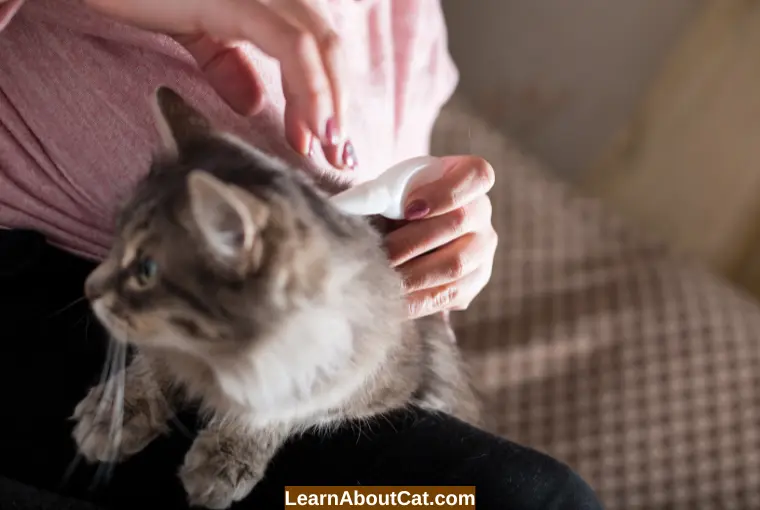
Getting rid of fleas is a vital part of treatment, as swallowing fleas while grooming will re-infect your cat. You must also clean their surroundings, change out the litter box daily, and keep your infected pet away from your other pets.
Once your cat is cured, deep cleaning of the house is essential as eggs can survive for weeks, and your pet can get re-infected.
How to Avoid Worm Infections in Cats
There is no way to prevent worms in your felines altogether; however, there are some ways to lower the chances of contracting a worm infection:

1. Keep your Pet Inside
Your pet gets worms from other infected animals or their feces. Keeping your cat inside won’t come in contact with these risk factors altogether. Alternatively, you can actively watch your cat when it is outside. Make sure it does not eat anything when it is outdoors, as that’s the easiest way to get worms.
2. Supervise Outdoor Cat
Try letting your cat outside only when you are nearby to supervise them if you don’t want them to be an indoor-only cat. Watch your cat’s food intake when it’s exploring. It is easy for a cat to become infected with worms from prey such as mice and birds.
3. Give Prophylactic Heartworm Medication
Because heartworm is the most dangerous parasite your pet can get, giving heartworm medicine once a month is an excellent way to prevent them altogether.
4. Prevent Fleas (flea medication)
When your cat spends most of its time outside, you’ll want to make sure it takes flea, heartworm, and worm-preventative medication. The tapeworm parasite is also carried by fleas, so it is advisable to keep fleas under control using a preventative medication.
Your veterinarian can advise you on preventative health care, like deworming your pet at least four times a year.
5. Groom Your Cat Regularly
It’s important to brush your cat’s coat once per week with a flea comb, especially if your cat is a long-haired breed that is prone to matting. Brushing will remove fleas before your cat gets infected.
6. Clean your Home Regularly
Outdoor cats regularly come in contact with soil and feces, so they can bring eggs into the house that can survive several weeks. Frequently vacuum to prevent infestation.
7. Clean the Litter Box Regularly
It is possible for infected fecal matter to spread to mites and fleas, which then spread the worms further. Ensure their waste is scooped daily and the litter box is emptied, cleaned, and refilled every week.
8. Keep your Pets Separate
If one of your pets is infected with this parasite, you need to keep other pets away from it. Separate their feeding bowls and litter boxes. This reduces the chance of transmission amongst pets, making the situation much more manageable.
Frequently Asked Questions
Can I touch my cat if it has worms?
Yes. It is possible for you to get infected by your cat if you keep close contact with him. It is therefore recommended that you avoid sleeping on the same bed as your cat, no matter how lovely he is and how cute he looks.
Hookworms can also enter humans accidentally (for instance, after petting a flea-infested pet). Walking across contaminated areas in your bare feet can expose you to hookworm larvae.
Can cat worms live on carpets?
Some worms can live on carpets for weeks and worm eggs can possibly survive for months on carpets. It is absolutely necessary for you to properly clean your carpets so that your cat does not become infected again and again.
Can worms survive in cat litter?
There are some worms that can survive for a long time in a litter box, while there are others that cannot. A few parasites found in cat stool are not infectious for the first few days after passing, such as Toxoplasma gondii.
Is it possible for tapeworms to live on furniture?
Yes, tapeworm cans live on furniture for several months. When a pet is infected with tapeworms and lays on upholstered furniture or curtains, it is likely that these items are contaminated with tapeworm eggs.
Although they can survive on furniture for months while waiting for a suitable host, they cannot develop or reproduce without a host.
Can cat worms live in bedding?
Yes. In bedding, cat worms can survive as sacs containing viable eggs often get stuck in the hairs around a pet’s anus, in excrement, or in places where the cat rests, such as a bed.
How often should I deworm my cat?
Recommendation: During the first few weeks of a kitten’s life, you should treat them for roundworms every 2 weeks up to the age of 8 weeks, then monthly until they are 6 months old.
In the case of adult cats (greater than 6 months old), you should treat them every three months.
How do I clean my house if my cat has tapeworms?
Deworm your cat and get rid of fleas so that you get rid of the source of worms. Use a flea spray around the house to kill fleas and their eggs. Then, wash all pet bedding in hot water.
You will also need to wash your own bedding if your cats laze around in your bed. Vacuum carpets thoroughly and steam them.
When should I clean the litter box after deworming?
Ideally, litter boxes should be cleaned every day. The benefit of this is that your cat will stay happier it will also keep it from making messes everywhere!
Should I change the litter after deworming?
Ideally, the litter box should be changed after deworming. It is best to change the litter box after deworming if you believe the worms in your cat were caused by the litter box. This will eliminate any chance of the worms contaminating your cat as a result of that.
Wrap Up!
Cleaning after a worm infestation is hard work but necessary because of the chances of re-infection (or transmission to you). The best way to keep worm infestations at bay is to regularly clean your house, your cat’s bedding, and your cat’s litter box.
The second best thing you can do if you have multiple pets at home is to keep them apart while this time is going on. If possible, provide your infected cat with her own litter box so she can stay away from other pets.
Your veterinarian is the best person to diagnose and treat your cat. Medical intervention and proper cleaning are the only ways to restore your cat’s health.
Related Posts:
Who is Isabella?
My name is Isabella, and I am a dedicated and knowledgeable cat enthusiast. With years of experience caring for cats and a deep love for felines, I made a mission to help other cat lovers navigate the challenges of cat ownership.

